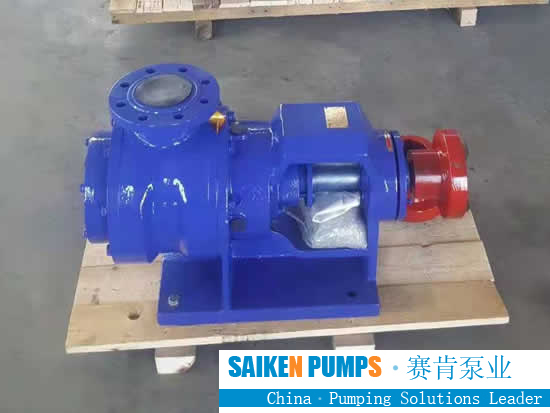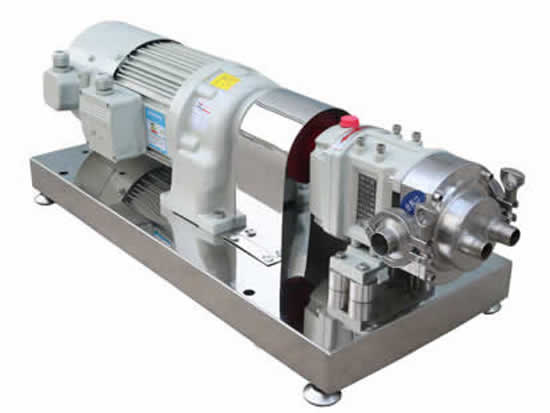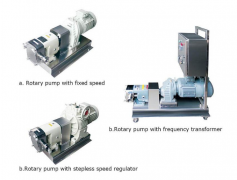High viscosity gear pump gears commonly have straight teeth, helical teeth, herringbone teeth, and spiral teeth. The tooth profile mainly has involute and circular arc types. Usually small gear pumps use involute spur gears, high temperature gear pumps often use shifted gears, and involute helical gears are used for melt pumps that transport high-viscosity and high-pressure polymer melts. The gear and the shaft are made into one body, and its rigidity and reliability are higher than that of a gear pumps that is manufactured separately from the gear and shaft. The gears of foreign low-pressure gear pumps often adopt a square structure, that is, the tooth width of the gear is equal to the diameter of the addendum circle. The tooth width of the high-viscosity gear pump used in high-pressure applications is smaller than the diameter of its addendum circle. This is to reduce the radial pressure area of the gear and reduce the load of the gear and bearing.
The heavier the pump casing of the gear oil pump, the higher the temperature and pressure resistance. The pump body is often made of ductile iron, or it can be made by casting aluminum alloy hard mold, or processed by extruded aluminum alloy profiles. When the conveyed medium is corrosive, stainless steel materials with higher cost can be used. Foreign high-viscosity gear pumps mostly use alloy steel with high nickel and chromium content as the pump casing material. This material has better overall performance in terms of strength, reliability and cost. In order to solve the problem of oil trapping in gear pumps, symmetrical unloading grooves are usually opened on the pump cover, or asymmetrical unloading grooves are opened toward the low pressure side. The suction side uses tapered unloading grooves, and the discharge side is rectangular. The depth of the groove and the unloading groove is also deeper than the gear pump used in the hydraulic industry.
Due to the high viscosity of the medium delivered by the high-viscosity gear oil pump, in order to reduce the flow resistance and improve the pump's liquid absorption capacity, the medium must be heated or insulated. Electric heating elements are usually used to heat the viscous liquid evenly. If the temperature fluctuation is not large and the high viscosity liquid being transported is prone to degradation, it is recommended to use the fluid heating method, especially the gear pump china with a large displacement. Fluid heating is divided into internal and external structures. The so-called built-in type refers to the design of a heat-protruding jacket inside the pump body or end cover of the gear pump, and the external type is to connect the heat jacket with the pump body through bolts. Whether steam, heat transfer oil, or cooling water should be passed into the jacket depends on the specific conditions of the medium. The built-in type is suitable for occasions that require high temperature uniformity of the conveyed liquid, or require uniform cooling of high-temperature liquids. When the electric heating method lacks safety or does not require high temperature control, an external structure can be used. The internal gear pump produced by the American company VIKING has a jacket on the pump head that can control the temperature of the conveying fluid. It can be equipped with an external jacket whether it is in a high temperature or low temperature environment.
The bearings of high viscosity gear oil pumps usually use sliding bearings, and a spiral flow channel is specially designed on the non-load bearing surface of the inner wall of the bearing. The rotation direction of the spiral groove is the same as the rotation of the gear shaft. The outer end of the bearing communicates with the liquid inlet of the pump, and the spiral groove at the inner end of the bearing communicates with the tooth root (vacuum part). When the shaft rotates, with the help of the spiral effect and the pressure difference between the two ends of the bearing, the low-temperature liquid outside the bearing is sucked into the bearing. After the bearing is lubricated and cooled, it flows into the teeth just disengaged to form a spiral with sufficient lubrication and fast heat dissipation. Self-priming low pressure lubrication system. The advantage of this lubrication method is that all the lubricating liquid entering the bearing is a low-temperature medium, and the viscous lubricating liquid is easy to form a dynamic pressure oil film with strong bearing capacity. A large amount of lubricating fluid circulates continuously to take away the heat of the bearing, which plays a good role in lubricating and cooling the bearing. Since there is sufficient liquid to fill the tooth roots that have just been disengaged, the self-priming performance of the gear oil pump is greatly improved, and the phenomenon of suction is avoided. It not only improves the volumetric efficiency, but also helps reduce cavitation and reduce noise.
Gear pump manufacturers and suppliers from China


